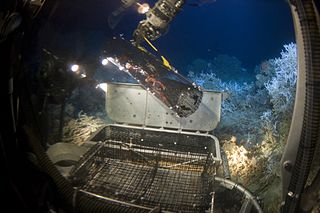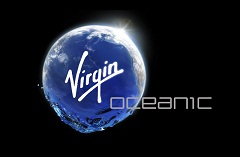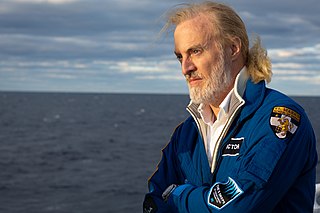
The Challenger Deep is the deepest known point of the seabed of Earth, located in the western Pacific Ocean at the southern end of the Mariana Trench, in the ocean territory of the Federated States of Micronesia. According to the GEBCO Gazetteer of Undersea Feature Names the depression's depth is 10,920 ± 10 m (35,827 ± 33 ft) at 11°22.4′N142°35.5′E, although its exact geodetic location remains inconclusive and its depth has been measured at 10,902–10,929 m (35,768–35,856 ft) by deep-diving submersibles, remotely operated underwater vehicles, benthic landers, and sonar bathymetry. The differences in depth estimates and their geodetic positions are scientifically explainable by the difficulty of researching such deep locations.

The Mariana Trench is an oceanic trench located in the western Pacific Ocean, about 200 kilometres (124 mi) east of the Mariana Islands; it is the deepest oceanic trench on Earth. It is crescent-shaped and measures about 2,550 km (1,580 mi) in length and 69 km (43 mi) in width. The maximum known depth is 10,984 ± 25 metres at the southern end of a small slot-shaped valley in its floor known as the Challenger Deep. The deepest point of the trench is more than 2 km (1.2 mi) farther from sea level than the peak of Mount Everest.

A bathyscaphe is a free-diving, self-propelled deep-sea submersible, consisting of a crew cabin similar to a Bathysphere, but suspended below a float rather than from a surface cable, as in the classic Bathysphere design.

A submersible is an underwater vehicle which needs to be transported and supported by a larger watercraft or platform. This distinguishes submersibles from submarines, which are self-supporting and capable of prolonged independent operation at sea.

A deep-submergence vehicle (DSV) is a deep-diving crewed submersible that is self-propelled. Several navies operate vehicles that can be accurately described as DSVs. DSVs are commonly divided into two types: research DSVs, which are used for exploration and surveying, and DSRVs, which are intended to be used for rescuing the crew of a sunken navy submarine, clandestine (espionage) missions, or both. DSRVs are equipped with docking chambers to allow personnel ingress and egress via a manhole.

Kaikō was a remotely operated underwater vehicle (ROV) built by the Japan Agency for Marine-Earth Science and Technology (JAMSTEC) for exploration of the deep sea. Kaikō was the second of only five vessels ever to reach the bottom of the Challenger Deep, as of 2019. Between 1995 and 2003, this 10.6 ton unmanned submersible conducted more than 250 dives, collecting 350 biological species, some of which could prove to be useful in medical and industrial applications. On 29 May 2003, Kaikō was lost at sea off the coast of Shikoku Island during Typhoon Chan-Hom, when a secondary cable connecting it to its launcher at the ocean surface broke.
The hadal zone, also known as the hadopelagic zone, is the deepest region of the ocean, lying within oceanic trenches. The hadal zone ranges from around 6 to 11 km below sea level, and exists in long, narrow, topographic V-shaped depressions.
A personal submarine is a submarine, usually privately funded and constructed, which is usually primarily intended for recreational use.

Deep-sea exploration is the investigation of physical, chemical, and biological conditions on the ocean waters and sea bed beyond the continental shelf, for scientific or commercial purposes. Deep-sea exploration is an aspect of underwater exploration and is considered a relatively recent human activity compared to the other areas of geophysical research, as the deeper depths of the sea have been investigated only during comparatively recent years. The ocean depths still remain a largely unexplored part of the Earth, and form a relatively undiscovered domain.

The Sirena Deep, originally named the HMRG Deep, was discovered in 1997 by a team of scientists from Hawaii. Its directly measured depth of 10,714 m (35,151 ft) is third only to the Challenger Deep and Horizon Deep, currently the deepest known directly measured places in the ocean. It lies along the Mariana Trench, 200 kilometers to the east of the Challenger Deep and 145 km south of Guam.

Virgin Oceanic is an undersea leisure venture of Newport Beach, CA businessman Chris Welsh and Sir Richard Branson, part of Sir Richard Branson's Virgin Group. The brand was first reported in a 2009 Time Magazine interview. The flagship service provided by Virgin Oceanic was intended to take visitors to the deepest parts of the ocean; however, as of late 2014, the project has been put on hold until more suitable technologies are developed.
DeepFlight Merlin is a personal submarine by Hawkes Ocean Technologies, part of the DeepFlight line of submersibles. The positively buoyant submersible was designed by Graham Hawkes. The Merlin was the first winged open-cockpit submarine available on the market, and first three-man submarine in the "aero submarine" class, representing a major advance in scuba diving technology.
Hawkes Ocean Technologies is a marine engineering firm that specializes in consumer submarines, founded by Graham Hawkes. It is headquartered in San Francisco, US.

Graham Hawkes is a London-born marine engineer and submarine designer. Through the 1980s and 1990s, Hawkes designed 70% of the crewed submersibles produced in those two decades. As late as 2007, he held the world solo dive record of 910 metres (2,990 ft) in the submarine Deep Rover.

Jiaolong is a Chinese crewed deep-sea research submersible that can dive to a depth of over 7,000 metres (23,000 ft), developed from the Sea Pole-class bathyscaphe. It has the second-greatest depth range of any crewed research vehicle of the Chinese Navy; the only crewed expeditions to have gone deeper were the dives of the Trieste bathyscaphe in 1960, Archimède in 1962, Deepsea Challenger in 2012, and DSV Limiting Factor in 2019.

Deepsea Challenger is a 7.3-metre (24 ft) deep-diving submersible designed to reach the bottom of the Challenger Deep, the deepest-known point on Earth. On 26 March 2012, Canadian film director James Cameron piloted the craft to accomplish this goal in the second crewed dive reaching the Challenger Deep. Built in Sydney, Australia, by the research and design company Acheron Project Pty Ltd, Deepsea Challenger includes scientific sampling equipment and high-definition 3-D cameras; it reached the ocean's deepest point after two hours and 36 minutes of descent from the surface.
DOER Marine is a marine technology company established in 1992 by oceanographer Sylvia Earle, based in Alameda, California.

Victor Lance Vescovo is an American private equity investor, retired naval officer, sub-orbital spaceflight participant, and undersea explorer. He was a co-founder and managing partner of private equity company Insight Equity Holdings from 2000-2023. Vescovo achieved the Explorers Grand Slam by reaching the North and South Poles and climbing the Seven Summits, and he then visited the deepest points of all of Earth's five oceans during the Five Deeps Expedition of 2018–2019.
Triton Submarines is a Florida-based company that designs and manufactures private submersibles for research, filming, deep-ocean exploration, and the luxury yachting and tourism sector. It was founded in 2007.











